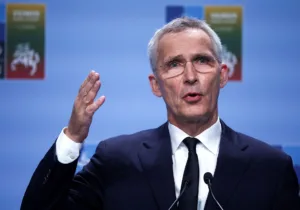The sixth round of talks to update the North American Free Trade Agreement (NAFTA) will begin later this month in Canada. But Canadian officials are increasingly concerned that President Trump will announce the United States will unilaterally withdraw—either as a negotiation tactic or as a way to shift toward Trump’s favored protectionism.
Here is what you should know about the perennially controversial trade agreement.
What is NAFTA?
NAFTA is the initialism for the North American Free Trade Agreement, an agreement signed by Canada, Mexico, and the United States that reduced or eliminated trade barriers in North America. Since the U.S. and Canada already had a free trade agreement (the Canada–United States Free Trade Agreement, which was signed in 1988, NAFTA merely brought Mexico into the trade bloc.
Negotiations for the trade agreement began in 1990 under the administration of George H.W. Bush and were finalized under Bill Clinton’s presidency in 1993. The House of Representatives approved the agreement by a vote of 234-200 (supporters included 132 Republicans and 102 Democrats), and the Senate version passed with a vote of 61-38 (supporters included 34 Republicans and 27 Democrats). The agreement went into effect on January 1, 1994.
What was the purpose of NAFTA?
In 1993 the European Union (EU) created a “single market”—one territory without any internal borders or other regulatory obstacles to the free movement of goods and services. This allowed every country and business in the EU to have access to more than 500 million consumers.
NAFTA, which was approved that same year, was designed to have a similar effect, providing a way to allow the exchange of goods and services to flow more freely across national borders without the artificial restrictions. NAFTA provided for the progressive elimination of all tariffs (through 2008) on any goods qualifying as North American. The deal also sought to protect intellectual property, establish dispute-resolution mechanisms, and, through corollary agreements, implement labor and environmental safeguards.
Why is NAFTA controversial?
As the Congressional Research Service notes, NAFTA was “controversial when first proposed, mostly because it was the first [free trade agreement] involving two wealthy, developed countries and a developing country.” Some people fear that allowing free trade with a developing country provides an incentive for U.S-based businesses to move their operations to that country.
For instance, in the 1992 presidential election, Reform Party candidate Ross Perot said, “We have got to stop sending jobs overseas. It’s pretty simple: If you’re paying $12, $13, $14 an hour for factory workers and you can move your factory South of the border, pay a dollar an hour for labor…have no health care—that’s the most expensive single element in making a car—have no environmental controls, no pollution controls and no retirement, and you don’t care about anything but making money, there will be a giant sucking sound going south.”
Since its implementation, NAFTA has remained a prime target of trade protectionists (those who advocate taking measures such as taxing imports to “protect” domestic industries from foreign competition).
What has been the effect of NAFTA on jobs in America?
Because of the complexity and variables involved, evaluating the impact of trade can be difficult—especially when trying to account for alternative effects. For example, many economists agree that while some low-wage American jobs were moved to Mexico, they were leaving anyway and would have likely gone to China or another Asian country. (As Wharton management professor Mauro Guillen says, “for every job we have lost in the U.S. to Mexico, five [jobs] were lost to China.”) But opening trade with Mexico also created additional jobs—many which are higher paying than those lost—that would not have existed without NAFTA.
However, contrary to the claims of protectionists like Donald Trump, the number of jobs lost is rather minimal, and the overall effect of the agreement has been positive. According to a 2014 PIIE study of NAFTA’s effects, about 15,000 jobs on net are lost each year due to the pact. (There are approximately 145,000,000 jobs in the U.S., so the loss accounts for less than 0.01 percent of all jobs.) However, for each of those jobs lost, the economy gains roughly $450,000 in the form of higher productivity and lower consumer prices because of NAFTA.
What has been the effect of NAFTA on the overall economy in the U.S.?
The net overall effect of NAFTA on the U.S. economy, while positive, appears to have been relatively modest, concludes the Congressional Research Service. NAFTA accounts for an annual increase in GDP of about 0.1 to 0.5 percent. The primary reason the effect is so negligible is that trade with Canada and Mexico accounts for a small percentage of U.S. GDP.
How has NAFTA affected relations between the U.S. and Mexico?
The Center for Strategic and International Studies notes that after NAFTA came into effect and the U.S. supported Mexico during its peso crisis in the 1990s, the relationship “gradually developed into one of mutual trust and cooperation on a widening range of issues, from fighting crime, energy and the environment, to defense and foreign policy.”
The anti-Mexico rhetoric during the 2016 presidential election, though, has drastically offset the goodwill Mexico had felt toward its northern neighbor. In 2015, 66 percent of Mexicans were favorable toward the U.S., and 29 percent were unfavorable. By September 2017, those numbers had flipped: 65 percent of Mexicans view the U.S. unfavorably, and 30 percent view the U.S. favorably. The share that holds a very unfavorable opinion of the U.S. has also increased since 2015, from 6 percent to 42 percent.
Could President Trump withdraw the U.S. from the agreement?
According to Article 2205 of the agreement, any of the three countries may withdraw from the treaty six months after it provides written notice of withdrawal to the other parties. If a country withdraws, the agreement remains in force for the remaining parties.
The U.S. Constitution doesn’t say which branch of the government has the power to terminate treaties. Historically, the president has been able to make such decisions unilaterally. However, NAFTA is a trade agreement, and congressional powers are highest in the arena of foreign commerce since Article I, section 8 of the Constitution gives Congress power “To regulate Commerce with foreign Nations, and among the several States, and with the Indian tribes.”
The text of the agreement doesn’t require congressional assent, though, and as Gary Clyde Hufbauer explains, President Trump could terminate NAFTA under Article 2205 and it would likely have no effect on H.R. 3450, the North American Free Trade Agreement Implementation Act, which was the domestic law that authorizes NAFTA.
What was the “NAFTA superhighway”?
In 1994, a non-profit trade group called North America’s SuperCorridor Coalition (NASCO) was created to promote transportation and related issues along Interstate Highways 35, 29, and 94. The group began referring to I-35 as the “NAFTA Superhighway” because that interstate carries a substantial amount of international trade with Mexico, the United States, and Canada.
Around 2006, conspiracy theories sprung up about the “NAFTA superhighway” on such websites as WorldNetDaily and in magazines like the John Birch Society’s The New American. The primary claim was that a cabal of government and business interest were planning to create a highway “four football-fields-wide, through the heart of the U.S. along Interstate 35, from the Mexican border at Laredo, Tex., to the Canadian border north of Duluth, Minn.” (As NASCO stated at that time, “There are no plans to build a new NAFTA Superhighway—it exists today as I-35.”)
Congressional representative and presidential candidate Ron Paul fanned the flames of the conspiracy by claiming this mythical proposal for a new NAFTA Superhighway was a threat to national sovereignty. As Paul said at the time, “The ultimate goal is not simply a superhighway, but an integrated North American Union—complete with a currency, a cross-national bureaucracy, and virtually borderless travel within the Union. Like the European Union, a North American Union would represent another step toward the abolition of national sovereignty altogether.”
In reality, what the NAFTA agreement created was the CANAMEX corridor. As defined by Congress in the 1995 National Highway Systems Designation Act, this is a “High Priority Corridor” through several states:
(26) The CANAMEX Corridor from Nogales, Arizona, through Las Vegas, Nevada, to Salt Lake City, Utah, to Idaho Falls, Idaho, to Montana, to the Canadian Border as follows:
(A) In the State of Arizona, the CANAMEX Corridor shall generally follow– (i) I-19 from Nogales to Tucson; (ii) I-10 from Tucson to Phoenix; and (iii) United States Route 93 in the vicinity of Phoenix to the Nevada Border.
(B) In the State of Nevada, the CANAMEX Corridor shall follow– (i) United States Route 93 from the Arizona Border to Las Vegas; and (ii) I-15 from Las Vegas to the Utah Border.
(C) From the Utah Border through Montana to the Canadian Border, the CANAMEX Corridor shall follow I-15.
—
Joe Carter is an adjunct professor of journalism at Patrick Henry College, an editor for several organizations, and the author of the NIV Lifehacks Bible.
Photo Credit: President Bush, Canadian Prime Minister Brian Mulroney, and Mexican President Carlos Salinas participate in the initialing ceremony of the North American Free Trade Agreement in San Antonio, Texas, on October 7, 1992. By David Valdez, via U.S. National Archives and Records Administration.







 Sponsor a student for Christianity & National Security 2024
Sponsor a student for Christianity & National Security 2024